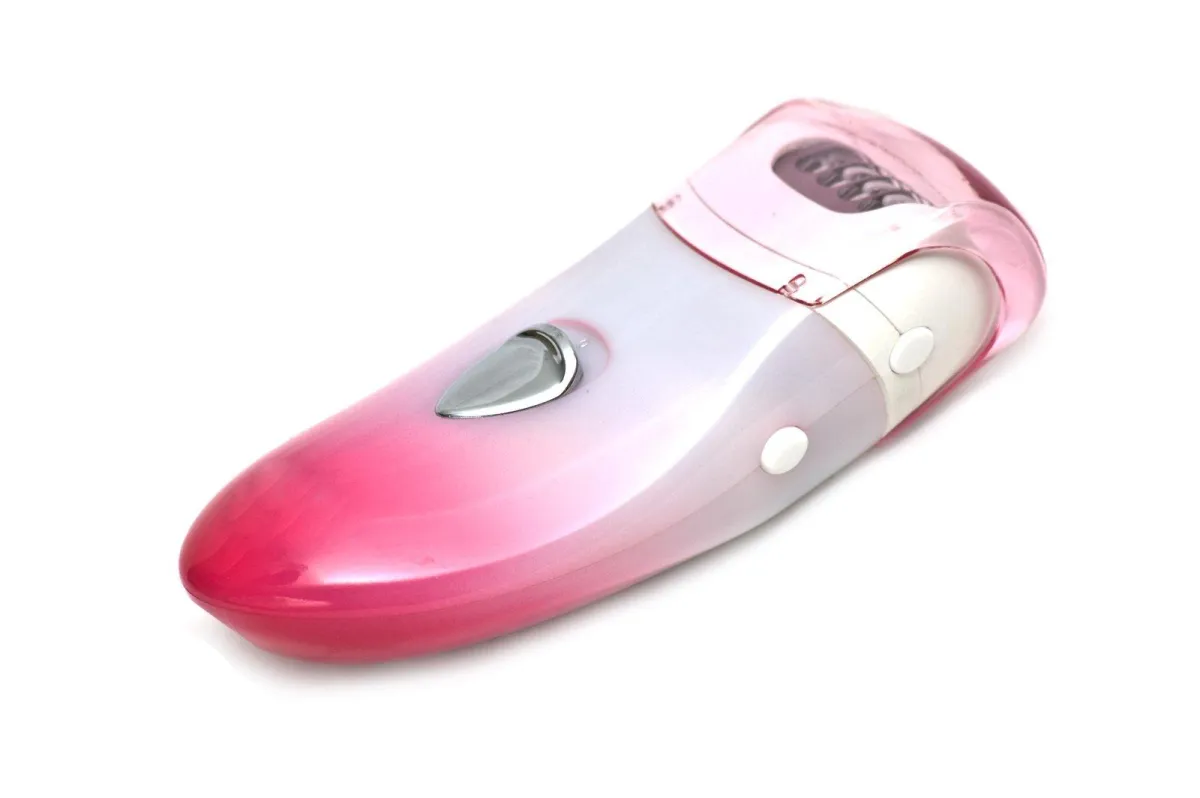
Epilating for Beginners: Tips and Best Practices
If you’re here reading this post, you are either wondering “what the heck is epilating?!” or you’ve already heard of it and you’re curious as to whether it’s the right hair removal process for you.
So, let’s start with the basics:
What is an Epilator?
Basically, it’s like 28 tweezers working on your body hair simultaneously. 🙂 Not exactly a gentle hair removal process but effective at providing that salon smooth skin without the price tag.
This is a basic, corded epilator with only the essentials.
There are many epilators available, from a basic model like mine (above) to cordless epilator models, complete with trimmer cap, shaver head, even a massage roller for all your unwanted hair needs.
What is epilating?
Epilation is the process of removing the hair from the root with an electrical tool that has tiny V-shaped teeth that grip the hair simultaneously and remove it.
Epilator Pros and Cons
There are several hair removal methods available like shaving, depilatory creams, and laser hair removal, but if you are looking for something that has longer-lasting results with minimal impact on your budget, then epilation is worth a try.
Pros
No mess
No burning (from wax) or cuts (from shaving)
Less hair regrowth needed between epilating (compared to waxing)
No prickly stubble
Faster than waxing
Relatively painless after the first few times
Efficient epilation requires less upkeep
You can epilate just about anywhere
Only need to epilate once every other week
Hair regrowth is softer and lighter
Cons
More expensive to start
Very painful the first time or two
Need some outgrowth before epilating again
Some of the links in this post may be affiliate links, you can read my full disclosure here or look for more information at the bottom of this post.
How to epilate
I will get into the Q’s and A’s of epilation in a minute, but first, a quick run-through of the process and how to epilate.
1. Exfoliate
Exfoliation is key to preventing ingrown hair by removing dead skin cells, providing a better epilating experience.
Plus, a nice hot shower opens up the pores and makes for easier hair removal.
Now, there are some who swear that epilating with wet hair is less painful (some epilate in the shower with a Wet/Dry Epilator), it’s worth trying both to see which you prefer.
2. Epilate
If you don’t have an epilator with a handy built-in light, then sit somewhere with plenty of natural light, which helps you see the fine hairs as well as the darker ones.
After you assemble your epilator, I recommend starting at your slowest speed.
I’m not going to sugarcoat this, the first time I epilated, it felt like getting stung over and over. And this was after waxing for a year.
To be fair, I didn’t have any epilator tips to make the process better, but you can benefit from my experience and hopefully have a better first go of it than I did.
(I should also say, two of my girls were epilating before they ever even tried shaving and they made it through just fine.)
I recommend starting at your ankles, as that tends to be less sensitive. Touch the epilator to your skin–don’t press too hard or it won’t grip the hair–and work upwards in small sections.
Keeping the epilator perpendicular to the skin works best for me, but try different positions to see what’s more comfortable.
You can work your way up one entire side or work in a 1-2 inch circle around the leg at a time. Again, this will depend on your comfort level.
When working with underarm hair, you will want to choose a slower speed and go slow, starting from the bottom and working your way to the top, where it’s more sensitive.
3. Moisturize
Your skin is going to be sensitive, especially the first time you epilate so moisturizing is key. (Do not lotion up before epilating or the teeth will have a harder time grabbing the hair.)
There are going to be numerous answers as to which is the best lotion to use after epilating, depending on who you talk to. But my suggestion is to find a non-fragranced lotion and apply it generously.
I have found that Liquid Coconut Oil works best for me but I have since switched to this awesome lotion because my dog would follow me around the house trying to lick my legs whenever I used the oil.
4. Rinse
Remove the epilator head and rinse it under running water. Most epilators come with a brush that helps dislodge hair which you can use at this time.
Fling the water from the head several times in the sink to further dislodge hair beneath the teeth. Rinse some more and repeat.
Dry against a towel, tapping several times. Then store away to further air dry.
Epilating Tips and Best Practices
This section answers the most common questions people have when it comes to epilating. Just keep in mind, these are my experiences, yours could always differ.
Do you epilate with or against the grain?
Just as in shaving, going against the natural direction of the hair allows the teeth to lift and grip the hair. There are some areas of the body, however, that may need you to swipe across in more than one direction.
What is the best hair length for epilating?
I have found that if I epilate every other week, the shorter hair length (about 1/4 inch) is perfect. If you are going from shaving to epilating, then you would want to try epilating 2-3 days after your last shave.
If you do go longer between epilating, go slower to prevent the longer hair from breaking off instead of getting pulled from the root
How to prevent ingrown hairs after epilating?
As I mentioned earlier, exfoliation is the key. You can make your own sugar scrub or find them in any store. I’m always partial to Himalayan Salt Scrubs.
How to use an epilator without pain?
The simple answer is: the more you use it, the less painful it is. I have been using one for years and it’s nothing for me to use one now. But it started getting markedly better by the second or third use.
The best thing to do is to keep the skin taut. Especially in areas like underarms and knees. Also, applying pressure to the skin directly above or below massively reduces any sensations you might feel.
There are also numbing creams for epilating, but I have never felt the need for any. Although, it might have been wonderful to have some numbing cream the first time I epilated…
When is the best time to epilate?
The short answer: when you are the most relaxed. If it’s the end of the day and you just had a nice, warm bath, I think that would be a perfect time.
This also allows any red bumps to dissipate and dry skin to soak up moisture before you go out again in the morning.
But I do mine in the morning because the light is better and that’s when I shower. So, again, this depends on your schedule and pain tolerance.
Another thing to keep in mind, you are more sensitive to pain during or right before your period, so best to plan this for afterward.
Does epilation reduce hair growth?
So, I can’t scientifically say for a fact yes or no. But what I can say is it makes the hair follicle softer and the hair tends to grow back in stages so it does seem like less hair.
I can go longer between epilation and the hair is so light, you can hardly tell.
Is it ok to epilate your pubic hair?
Yes, but as you know, it’ll be more sensitive (and time-consuming) than other areas. I highly recommend getting used to your legs first. At the very least, work on the bikini area first.
You also want to pay extra attention to keeping skin taut and if you can trim the hair short beforehand, it will help prevent it from breaking during epilating.
Is there a least painful epilator?
The process of hair removal such as epilating is going to be painful or uncomfortable, no matter which kind you buy. That said, there are ways to minimize the discomfort.
Buying an epilator with options will always be best. This way you can try speeds and attachments and see which ones suit you best. It should also have the wet/dry option as epilating in the shower seems to be preferred to those with sensitive skin.
I do want to mention here if your skin gets irritated beyond the normal red bumps, consider waiting longer to epilate again or maybe go with another method entirely.
Is there an epilator for eyebrows?
Yes, there are several brands that offer epilators for facial hair which I highly recommend instead of trying to use a regular epilator for the job. They’re just too big for such a small surface area.
Some of these come with cleaning brushes and a pouch. It’s an extra expense, but if you want the best tools for a space that gets the most exposure, you want something that’s going to get the job done right.
Conclusion
There are many options out there for hair removal. Some painless, some not so much. But if you weigh the pros and cons of each (which you can read about here) then you’re sure to find one that fits you best.
Which will be different for everyone. For me, epilating was the best option, hands down.
My girls, on the other hand, decided that shaving was better in the end.
Whatever you decide, I’d love for you to at least give epilators a shot. Not just once, because the first time is torture. But after a couple of tries, you might just find yourself addicted to the results.
*As an Amazon Associate, I earn from qualifying purchases, but if I am recommending an item in my post, it is only because I have used it myself or have done enough research on the product to feel it is a good fit for my readers.
© 2023 Freedomkit | Powered by Freedomkit.ai

